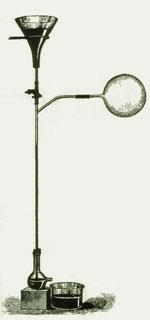Artisan Vacuum Tubes and the Great Radio Controversy
The above photo features a home-made vacuum tube. Image courtesy of hackaday.com
Not too long ago, I watched a video about ham radio that was produced by the YouTuber who goes by the name “Devon Stack.” Mr. Stack has a channel called “Black Pilled.” Stack’s video about ham radio discussed the ins and outs of this creaky old technology, and frankly, despite this video offering valuable information, I still felt disinclined to watch it from start to finish — unless driven by some sense of duty. I felt quite bored with Stack’s video about old ham radio technology because it was quite factual and dry, plus, it had very limited visual appeal. Despite having a subject matter that was markedly technical and dry, this video still pointed to an interesting issue; namely, the prospect of utilizing ham radio technology as a back-up plan if — or when — the internet either becomes unusable due to infrastructure related problems, or if the internet gets deliberately shut down.
The image above is a screen capture of Devon Stack’s YouTube video about ham radio. A link to the Black Pilled video about ham radio can be found below.
Ham radio is definitely not a new thing, in fact, a simple Wikipedia.org search shows that the first ham radio club started in 1908 at Colombia University. The original Colombia University radio club was called Clubradio hobby, and radio broadcasting in general, did not become very popular until the 1920s.
By the 1950s and 1960s, the number of ham radio operators across the world was in the millions, and people from all over the world were able to communicate with one another via ham radios. Despite seeing high levels of popularity in the middle years of the 20th century, ham radio has been a dying hobby for decades. So, why has ham radio been slowly going gently into that good night for the last few decades? The answer to the previous question seems to hinge on new technologies emerging. Despite ham radio functioning as a chew-toy for the high-the Wireless Telegraphof Columbia University, and this easily found online record that lists the earliest ham radio club seems quite believable; however, the hamIQ and left-brained, this great old hobby has seen better days because the internet now serves the same social functions previously filled by long-distance radio communications.
Despite suffering from old age, having a thick coating of dust, and being covered in liver spots, the ham radio technology is now worth re-considering as an alternative to conventional communications through the internet. So, why is ham radio now worth reevaluating? Vacuum- tube-based ham radio now seems to be worth a second look because this yesteryear-tech has the potential to become a back-up to the world wide web. Ham radio is an attractive option to supplement, or perhaps replace, present-day internet communications because, unlike the internet, a ham-radio-based communication network does not rely on any centralized and capital-intensive infrastructure; therefore, a decentralized, simple, and inexpensive ham radio network is going to be hard for a totalitarian state to censor, sabotage, or shut down.
A decentralized network of ham radios also has the ability to offer long-distance communications that span continents and cross oceans. Given the ham radio technology’s low cost, long reach, and decentralization, it should come as no great shock that plans to ban this equipment have already been quietly set in motion.
An example of ham radio’s long reach can be illustrated by the fact that one of the neighborhood kids I grew-up with had a dad who was an avid ham radio enthusiast; thing is, my friend’s dad regularly boasted about his weekly chats with his ham radio buddy who just happened to be a climate scientist stationed at the McMurdo research base. For those of you who have not heard of the McMurdo Station; it is located in Antarctica.
Indeed, there is continuing growth of “Alt-Tech” that typically takes the form of new social media network proprietors who are willing to provide political dissidents with uncensored and anonymous platforms where they can voice their opinions. In the realm of alt-tech, places like BitChute.com and Minds.com may serve as examples of places where the principles of free speech and anonymity are being put into action; none the less, despite the promising possibilities offered by the growth of various online alt-tech platforms, the very real prospect of an ever-less free internet still lurks in the woods.
Although many people living in America might presently feel that their internet freedoms are reasonably secure, troubling incidents like Russia making moves to ban virtual personal networks back in 2017 still assemble causes for concern. Other troubling incidents relating to the issue of internet freedom of speech include the arrests of 789 people just in the city of London alone over the course of 2015. The 789 people previously mentioned were arrested for the heinous crime making wrong-think posts on Facebook.
Let us also not forget that WordPress.com has pulled websites that ZOG dislikes, and GoDaddy.com has also yanked the domains for white nationalist websites, so yes, it does make sense for white nationalist mustache-twisters to begin constructing a decentralized communication network based on ham radios that could serve as a back-up to a forthcoming closed-off, heavily censored, and China-inspired version of our beloved internet.
Yes, Devon Stack’s video about ham radio did furnish some rather interesting information, but the most intriguing piece of information I gleaned from watching his video did not come from the actual video itself, but instead, the most interesting take-away came from the carnival side show of real-time comments brought to the public courtesy of Stack’s live-stream listeners. The live-stream comments that caught my eye above all others came from a few listeners who were discussing their plans to begin making their own in-house vacuum tubes.
The idea of making vacuum tubes at the community level is worth considering because vacuum- tube-based ham radios can be easily built, serviced, and repaired for a very low cost, and having the capability to procure all of the needed replacement parts for simple vacuum tube radios in- house makes the task of shutting-down a decentralized network of vacuum-tube-based ham radios difficult to say the least.
An added bonus that comes with the ability to make vacuum tubes in modest workshops is to also have the tooling needed to manufacture artisan “Edison” lightbulbs. Basic Edison light bulbs can easily be created by using the same equipment, and many of the same components, used to make vacuum tubes. So, think of having local access to inexpensive and easily repaired lightbulbs as a perk that would arise along with the process of establishing a cottage industry of artisan vacuum tube manufacturing.
Interestingly, there is already a thriving market for artisan lightbulbs on places like Etsy.com It seems that many people have recently come to love the aesthetics of old Edison lightbulbs, and taking advantage of their softer lighting is now an established method of choice for creating intimate and cozy atmospheres in homes and public spaces. A 2017 article featured on pacificstandard.com lamented the fact that the number of Edison lightbulbs that can be counted while walking the sidewalk of a city block is now a solid numerical indicator of just how far the disease of gentrification and the creep of whiteness has advanced within an urban enclave. Fortunately, making in-house lightbulbs is a whole lot faster and easier than making vacuum tubes that are inspired by consuming distilled spirits of questionable quality and origin or by listening to old tunes belted-out by the likes of Steve Earl and the Kentucky Headhunters.
Unlike vacuum tubes, all of the internal components needed to make lightbulbs can be sourced and manufactured on a local level, and the filaments in Edison-style lightbulbs can easily be made from small cuttings of bamboo stalks that have been cooked in well-sealed and airtight containers included in pottery kiln firings5. Once made, a typical bamboo-filamented Edison light bulb offers its users around 1200 hours of illumination.
The image above shows an artisan Edison lightbulb with a glass casing made by traditional glassblowing techniques. Photo courtesy of johanfrancoise.blogspot.com
Old glass bottles of all types, and even old canning jars, can easily be repurposed as lightbulbs; provided that a proper vacuum can be established. Image courtesy of makezine.com
The image at left features a light bulb made back in 2011. The lightbulb seen in the photo at left was made from a finished bottle of Bacardi rum. Image courtesy of permies.com
True, making titanium and tungsten wire at the homestead level does not seem very plausible; none the less, having large stockpiles of the needed components for making backwoods vacuum tubes would mean that bespoke heirloom radios could be constructed and maintained on the community level for centuries if needed.
Examples of vacuum tubes lasting for decades are not terribly unusual, and these stories of long-lived and Methuselah-like vacuum tubes often relate to old guitar amplifiers that were built in the 1960s which have remained in use up to the present day. Other testaments to the longevity of vacuum tubes can be found in tales of antediluvian British radio stations that used the same funky old equipment from the 1930’s through the early 1990s. The life of a vacuum tube in the old British long-wave radio station called Radio 4 was around 10 years, so a supply of the same old vacuum tubes was forced to last the entire length of long-wave radio’s 60-year run of use7. However, a typical vacuum tube will have a service life between 5,000 and 10,000 hours, which adds-up to just over one year of continual use.
Another nice feature offered by vacuum tubes is the fact that if a tube goes bad, then it can be repaired by opening its glass shell and simply cutting a properly sized new piece of tungsten wire to replace a burned-out section of filament. The next step in the repair process for a burned-out vacuum tube would be to remove the bad piece of wire and then secure a new piece of wire into the same place where the old section of filament went bad. If one piece of filament burns-out in a vacuum tube, then all of the sections of internal tungsten wire can be easily replaced at the same point in time.
Basically, if a vacuum tube goes bad, then its glass casing can be opened, the internal components can be repaired, and finally, the newly repaired tube can be resealed and put back to work. So, what is the upshot is this rambling? The point to remember: Individual vacuum tubes can be cheaply, quickly, and easily repaired in-house, and individual vacuum tubes can potentially remain in use for decades, or possibly even centuries.
Another angle to consider when owning a vacuum tube radio is the fact that diagnosing problems with these devices will mostly consist of testing each vacuum tube until the defective one is identified. Troubleshooting a vacuum tube radio may also involve testing a limited number of simple electric circuits for continuity.
Essentially, troubleshooting and repairing a vacuum-tube-based electronic device does not require a whole lot of specialized training, nor does becoming an amateur repairman for a vacuum-tube radio require investing in a wide variety of expensive equipment. So, a typical family could easily keep their vacuum tube radio running for decades without any professional help while spending pennies on the dollar. The ease and low cost of troubleshooting and repairing vacuum-tube-based electronic products actually makes them viable choices for a wide variety of consumer goods, even when a lot of newer and slicker stuff is readily available.
The above image shows a very rudimentary, yet still usable, vacuum tube radio designed and assembled by an electronics hobbyist in Cleveland, Ohio. Image courtesy of radioboatanchor.com
After watching about half of Stack’s video, I then went about searching online for information about how to make vacuum tubes in a home workshop. After a brief bit of searching, I discovered that there are quite a few videos posted on YouTube that provide information about how to make your own vacuum tubes. Examples of YouTube channels that feature how-to videos for making artisan vacuum tubes include the FilmsJp channel that features vacuum-tube- making videos furnished courtesy of the Frenchman Claude Paillard. The YouTube channel called Computer Hardware Repairing also features a pretty decent video about how to make your own vacuum tubes.
In addition to discovering a rich supply of online how-to videos for making vacuum tubes, I also learned that many electronics posting forums like elecronicspoint.com, and tubecrafter.com provide a lot of relevant information for those seeking to construct their own vacuum tubes for the first time. Lastly, many different books about vacuum tubes and how to make them are available from various online book sellers. Examples of books about vacuum tubes that are sold on Amazon.com include Inside the Vacuum Tube by John F. Rider, and Getting the Most Out of Vacuum Tubes by Robert Tomer.
Manufacturing vacuum tubes can be thought of as a valuable cottage industry for the 21st century because the organic development of a down-home cottage industry made-up of artisan vacuum tube manufacturers would allow people living in rural areas to produce their own reliable and inexpensive consumer items. Some of the consumer items that can be made from vacuum tubes include stereos, AM/FM radios, shortwave radios, adding machines, and yes, even very basic television sets and computer monitors can be made from vacuum tubes. A YouTube video I watched several months ago that was posted on a channel I cannot remember, nor relocate, featured a Czech university student who built a simple and robust television set and computer monitor out of old military-surplus Russian-made vacuum tubes from the Soviet era. The total cost for this Czech science project was less than 20 USD.
Fortunately, it turns out that vacuum tubes can be made in a home workshop without putting- in too much time or labor, and the set-up cost to get a small vacuum tube factory up-and- running is surprisingly modest. The only materials needed to make the vacuum tubes themselves are glass, tungsten and titanium wires of various diameters, nickel sheeting, and nickel wires of varying thicknesses. Keeping a supply of isopropyl alcohol and acetone to clean and prepare the components of future vacuum tubes helps as well. Having mica sheeting is also nice, but not absolutely necessary.
Some of the items of manufacturing equipment needed to turn glass and metal into vacuum tubes include a torch for shaping the glass, a pump that can produce a sufficient vacuum within a glass tube, tin snips, a hammer, an anvil, and a spot-welding machine. As far as I have ascertained, having solder is handy, but not absolutely necessary for the production of in-house farmer’s-market-style vacuum tubes.
I have also perused a few forum posts that discussed how vacuum tubes of decent quality can be made with affordable vacuum pumps manufactured in China. Although not all of the components that constitute a working vacuum tube can be made at the village level, components like titanium wire and tungsten wire are very cheap and easy to obtain;Amazon.com and Alibaba.com both sell spools of tungsten and titanium wire fit for making vacuum tubes.
Unfortunately, the cynic in me is now urging people to begin stockpiling the components needed to manufacture vacuum tubes that cannot be easily produced at the community level. For those interested in fighting the powers that be, I recommend stockpiling items like tungsten wire suitable for manufacturing vacuum tubes. Interestingly, the tungsten wire that is best- suited for making vacuum tubes contains minute traces of thorium in the alloy. Let’s also not forget to stockpile titanium stripping and vacuum pumps suitable for producing electronic components. Presently, I believe that as many people as possible should stockpile the largest amounts of certain basic electronics manufacturing materials and equipment as they can because I think that ZOG will soon begin looking for ways to restrict access to these items.
It is also worth discussing the Sprengel Pump at some point. The Sprengel Pump is a relatively simple device with no moving parts that is capable of producing the kind of hard vacuums needed to manufacture lightbulbs and vacuum tubes. The Sprengel Pump is named after its inventor, the German chemist named Herman Sprangel. Sprangel’s pump was invented while he was working in London in 1865.
A Sprengel Pump works by having drops of liquid fall across an enclosed space and take a little bit of gas within this space with each drop. A good Sprengel Pump is capable of developing the kinds of vacuums needed to make vacuum tubes within about 20 minutes. The earliest Sprengel Pumps used drops of falling liquid mercury to achieve their vacuums, yet various types of silicone-based oils have been found to be an effective substitute for liquid mercury. Luckily the silicone-based oils that work as liquids aside of Sprengel pumps are recyclable for years.

The illustration above shows a Sprengel Pump. Image courtesy of wikipedia.org

The image above shows a classic illustration of a Sprengel pump like Thomas Edison used to make his early light bulbs. Image courtesy of chemistryworld.com
Sorry folks, pumps like the one pictured above will not suffice for making vacuum tubes or lightbulbs. Image courtesy of dailydot.com
Notes
1. Dick Norton, “Report Causes Concern and Confusion in California’s Amateur Radio Ranks,” October, 25, 2019 ranks
2. Timothy B. Lee, “GoDaddy has shut-down Richard Spencer’s white supremacist site,” May 7, 2018, https://arstechnica.com/tech-policy/2018/05/godaddy-has-shut-down-richard-spencers-white- supremacist-site/
3. David Meyer, “VPN providers pull Russian servers as Putin’s ban threatens to bite,” March 29, 2019, bite/
4. Sadie Levy Gale, “Arrests for offensive Facebook and Twitter posts soar in London,” July 4, 2016, soar-in-london-a7064246.html
5. Elizabeth Palermo, “Who Invented the Light Bulb?” August 17, 2017, https://www.livescience.com/43424-who-invented-the-light-bulb.html
6.”Incandescent Lamps: The most profound invention since man-made fire” January 22, 2012, https://edisontechcenter.org/incandescent.html
7. Dan Sabbagh, “Radio 4’s Long Wave Goodbye,” October 9, 2011, https://www.theguardian.com/media/2011/oct/09/bbc-radio4-long-wave-goodbye
8. Post #2 of 44, “How long is the lifespan of tube amp,” April 4, 2003, https://www.head-fi.org/threads/how-long-is-the-life-span-of-tube-amp.138377/
9. Dan Moloney, “Home Brew Vacuum Tubes are Easier than You Think,” May 4, 2016, https://hackaday.com/2016/05/04/home-brew-vacuum-tubes-are-easier-than-you-think/












